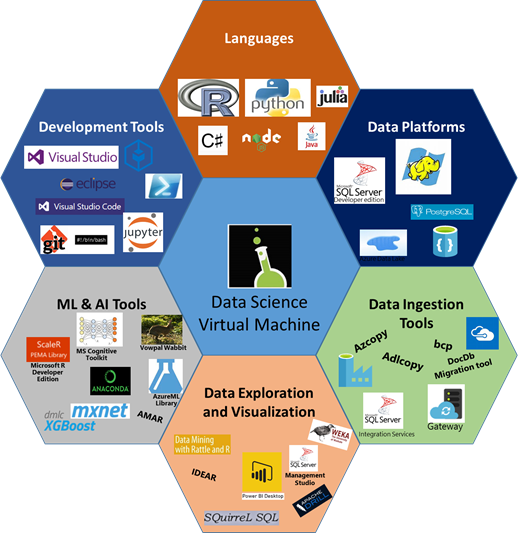New Year & New Updates to the Windows Data Science Virtual Machine
This post is authored by Gopi Kumar, Principal Program Manager in the Data Group at Microsoft.
First of all, a big thank you to all users of the Data Science Virtual Machine (DSVM) for your tremendous response to our offering in 2016. We're looking forward to a similarly great year in 2017.
The new year also brings in some interesting new tools to our DSVM users, to help you be more productive with data science. In this post, we summarize key recent changes on the Windows Server side of our DSVM offering, below.
- Microsoft R Server 9.0.1 (MRS9) developer edition, a major update to the enterprise scalable R extension from Microsoft, is now available on the VM. This version brings a lot of exciting changes including several fast ML / deep learning algorithms developed by Microsoft in a new library called Microsoft ML. There's a new architecture and interface for deploying R models and functions as web services, this follows a paradigm and interface library very similar to Azure ML operationalization. The library is called mrsdeploy. We have some R deployment samples for both notebook and R Tools for Visual Studio (RTVS) and RStudio. The olapR package in Microsoft R Server lets you run MDX queries and connect directly to OLAP cubes on SQL Server 2016 Analysis Services from your R solution. SQL Server 2016 Developer edition and the associated Microsoft R In-DB analytics is also updated to Service Pack 1.
- R Studio Desktop open source edition is now preinstalled into the VM, by popular demand.
- R Tools for Visual Studio is now updated to version 0.5, bringing in multi-window plotting and SQL tooling to run R code on SQL Server 2016.
- Microsoft Cognitive Toolkit (formerly called CNTK) is now on Version 2 Beta 6, and features several improvements and sample notebooks to perform fast deep learning using Python interface or the CNTK Brainscript interface.
- Apache Drill , a SQL based query tool that can work with various data sources and formats (e.g. JSON, CSV), was part of our previous update. We now prepackage and configure drivers to access various Azure data services such as Blobs, SQLDW/Azure SQL, HDI and Document DB. See this tutorial in our gallery for information on how to query data in various Azure data sources from within the Drill SQL query language.
- JuliaPro is available to DSVM users and is now pre-installed and pre-configured on the VM, thanks to Julia Computing (a company founded by the creators of Julia programming language). JuliaPro is a curated distribution of the open source Julia language along with a set of popular packages for scientific computing, data science, AI and optimization. The JuliaPro distribution comes with an Atom based IDE, Jupyter notebooks and several sample notebooks on the DSVM Jupyter instance to help you get started. Julia Computing also provides an Enterprise edition with commercial support.
- The Deep Learning Toolkit for the Windows DSVM is an extension to help you jump start deep learning on Azure GPU VMs, and without having to spend time installing GPU framework dependencies and drivers or configuring the various deep learning tools. This extension has been updated to include the latest versions of CNTK 2, mxNet for GPU along with new samples. It also features the Windows version of TensorFlow.
We also offer a Linux Edition of the data science virtual machine and there will be a separate post on major updates there.
Meanwhile, here are some resources to get you started with the DSVM.
Windows Edition
- Documentation: https://azure.microsoft.com/en-us/documentation/articles/machine-learning-data-science-provision-vm/
- Article/Tutorial – Ten things you can do on the DSVM: https://azure.microsoft.com/en-us/documentation/articles/machine-learning-data-science-vm-do-ten-things/
- Link to Create DSVM instance: https://azure.microsoft.com/marketplace/partners/microsoft-ads/standard-data-science-vm/
- Link to Create DSVM instance for deep learning on GPU: https://aka.ms/dsvm/deeplearning
Linux Edition
- Documentation: https://azure.microsoft.com/en-us/documentation/articles/machine-learning-data-science-linux-dsvm-intro/
- Link to Create DSVM instance: https://azure.microsoft.com/marketplace/partners/microsoft-ads/linux-data-science-vm/
Webinar
- https://channel9.msdn.com/blogs/Cloud-and-Enterprise-Premium/Inside-the-Data-Science-Virtual-Machine (Duration: 1 Hour)
I'd like to end this post with a graphical summary of the DSVM, showing a [non-exhaustive] list of the various tools that are preinstalled. DSVM helps you focus more on data science and spend less time on installing, configuring and administering tools, thereby making you more productive. Give DSVM a shot today and send us feedback on how we can make it even better for your data science needs.

Gopi